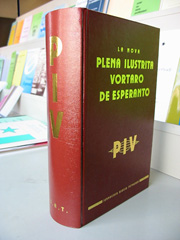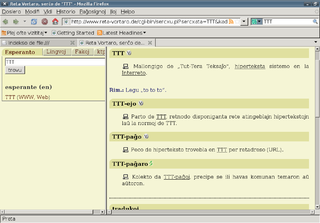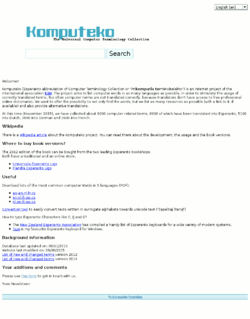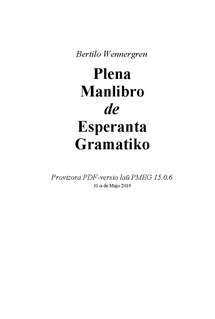
La Plena Pekoteko is a three-volume terminology collection extending to 1,816 pages. The word Pekoteko is an abbreviated version of Per-komputora termino-kolekto ("Computerized terminology collection").

La Plena Pekoteko is a three-volume terminology collection extending to 1,816 pages. The word Pekoteko is an abbreviated version of Per-komputora termino-kolekto ("Computerized terminology collection").
Rüdiger Eichholz, from 1976 a member of the Akademio de Esperanto, at that time headed the Academy's technical/specialized dictionaries section. Collaborating with other Esperantists from 1968 to 1981, he maintained the Slipara Vortaro, an indexed collection of word-definition slips. Later, during the personal computer era, he started working on the Pekoteko database project. [1]
Other major contributors to this project were Bernhard Eichkorn, Bernhard Pabst and Edward Spitaels. Terminology proposals were collected between 1985 and 1990. In the foreword to the Pekoteko, Eichholz wrote: "We did not lose time in vain efforts to standardize the terms to be used for Esperanto. We simply offer them, and recommend to all readers who may require some [translated] terms, to consult our records, to read the arguments presented and to select those terms that, after reading the arguments, they judge most on-point."
In the Pekoteko the editors made a few suggestions; especially remarkable was the now-dead proposal to add the non-canonical suffix -apo for computer-related terms, such as the neologisms *desegn/apo, intended to mean "computer program for drawing" or *financ/ap/aro to mean "financial software suite"; neither term was actually adopted by the Esperanto community.
The Pekoteko was printed in 1992 by the Canadian publishing house Esperanto Press after receiving financial support from the FAME Foundation established by Franz Alois Meiners. The project promoter distributed 150 copies as gifts to all members of the Academy of Esperanto, to the editorial staff of important Esperanto magazines and to a few libraries and museums. The remaining 150 units were sold.
Little is currently still heard about the Pekoteko. Nowadays the terminological work is accomplished quite differently, and the Pekoteko files are no longer directly usable. Some Esperantists, however, thought it was a great pity that the information contained therein was no longer readily available. It is possible that someone might now discuss correct terminology without knowing that the same discussion had already taken place 20 years earlier. [1] In 2006, therefore, Bernhard Pabst converted the former WordPerfect files in his possession to a plain-text format, which he and André Weber then supplemented with additional entries. Pabst then converted the text file to PDF and made it available for download "to quickly and easily provide the public with information, not to recreate a perfect Pekoteko but only to provide basic control of the content." [1]
The work of Pekoteko's creators inspired people such as Yves Nevelsteen, author of Vikipedio – praktika manlibro ("Wikipedia – a practical handbook") to create Komputeko a printed and on-line multilingual collection of computer terms. Numerous Esperanto words that first appeared in the Pekoteko are actually in use today to refer to computer hardware.

In communications and information processing, code is a system of rules to convert information—such as a letter, word, sound, image, or gesture—into another form or representation, sometimes shortened or secret, for communication through a communication channel or storage in a storage medium. An early example is the invention of language, which enabled a person, through speech, to communicate what they saw, heard, felt, or thought to others. But speech limits the range of communication to the distance a voice can carry, and limits the audience to those present when the speech is uttered. The invention of writing, which converted spoken language into visual symbols, extended the range of communication across space and time.

Esperanto is the most widely spoken constructed international auxiliary language. It was created by Polish ophthalmologist L. L. Zamenhof in 1887. Zamenhof first described the language in The International Language, which he published in five languages under the pseudonym "Doktoro Esperanto". The word esperanto translates into English as "one who hopes".
L. L. Zamenhof developed Esperanto in the 1870s and 80s and published the first publication about it, Unua Libro, in 1887. The number of Esperanto speakers has grown gradually since then, although it has not had much support from governments and international organizations and has sometimes been outlawed or otherwise suppressed.

In computer graphics, a raster graphics or bitmap image is a dot matrix data structure that represents a generally rectangular grid of pixels, viewable via a monitor, paper, or other display medium. Raster images are stored in image files with varying formats.
A translation memory (TM) is a database that stores "segments", which can be sentences, paragraphs or sentence-like units that have previously been translated, in order to aid human translators. The translation memory stores the source text and its corresponding translation in language pairs called “translation units”. Individual words are handled by terminology bases and are not within the domain of TM.

Desktop publishing (DTP) is the creation of documents using page layout software on a personal ("desktop") computer. It was first used almost exclusively for print publications, but now it also assists in the creation of various forms of online content. Desktop publishing software can generate layouts and produce typographic-quality text and images comparable to traditional typography and printing. Desktop publishing is also the main reference for digital typography. This technology allows individuals, businesses, and other organizations to self-publish a wide variety of content, from menus to magazines to books, without the expense of commercial printing.
In computing, DOC or doc is a filename extension for word processing documents, most commonly in the proprietary Microsoft Word Binary File Format. Historically, the extension was used for documentation in plain text, particularly of programs or computer hardware on a wide range of operating systems. During the 1980s, WordPerfect used DOC as the extension of their proprietary format. Later, in 1983, Microsoft chose to use the DOC extension for their proprietary Microsoft Word format. These uses for the extension have largely disappeared from the PC world.
Computer-assisted translation or computer-aided translation (CAT) is a form of language translation in which a human translator uses computer hardware to support and facilitate the translation process.
Norvega Esperantista Ligo was founded in 1911. As the Norwegian arm of the Esperanto movement, its aim is to spread knowledge and use of the international language Esperanto. The league has a modest size of a couple of hundred members, and work done within NEL is mostly voluntary. The youth wing of NEL is Norvega Junularo Esperantista.
A binary file is a computer file that is not a text file. The term "binary file" is often used as a term meaning "non-text file". Many binary file formats contain parts that can be interpreted as text; for example, some computer document files containing formatted text, such as older Microsoft Word document files, contain the text of the document but also contain formatting information in binary form.
Esperanto and Interlingua are two planned languages which have taken radically different approaches to the problem of providing an International auxiliary language (IAL).
The Baháʼí Esperanto League (BEL) is the official organization of Baháʼís who are Esperantists. It was founded on 19 March 1973 with the approval of the Universal House of Justice.
Data conversion is the conversion of computer data from one format to another. Throughout a computer environment, data is encoded in a variety of ways. For example, computer hardware is built on the basis of certain standards, which requires that data contains, for example, parity bit checks. Similarly, the operating system is predicated on certain standards for data and file handling. Furthermore, each computer program handles data in a different manner. Whenever any one of these variables is changed, data must be converted in some way before it can be used by a different computer, operating system or program. Even different versions of these elements usually involve different data structures. For example, the changing of bits from one format to another, usually for the purpose of application interoperability or of capability of using new features, is merely a data conversion. Data conversions may be as simple as the conversion of a text file from one character encoding system to another; or more complex, such as the conversion of office file formats, or the conversion of image formats and audio file formats.

Plena Ilustrita Vortaro de Esperanto is a monolingual dictionary of the language Esperanto. It was first compiled in 1970 by a large team of Esperanto linguists and specialists under the guidance of Gaston Waringhien and is published by the Sennacieca Asocio Tutmonda (SAT). It may be consulted [Vortaro.net online] for free.
Rüdiger Eichholz, was a Canadian physicist and Esperantist and a member of the Esperanto Academy. He is best known for publishing the "Esperanto picture dictionary" (1988) and a massive anthology co-edited with his wife, Esperanto in the Modern World (1982).
Esperanto has been mostly stable since its creation, especially as compared to other constructed languages. This is due to the Declaration of Boulogne in 1905, which made the early works of Zamenhof binding; most attempts to change the language have been therefore seen as distinct language projects, and in the main the Esperanto community has ignored them. The main change in the language has been a great expansion of the vocabulary, largely driven by translations of technical jargon, which is explicitly allowed for by Boulogne. However, there have been more subtle changes to syntax and semantics as the majority of Esperanto authors shifted from native speakers of Slavic and German to other languages, such as French and English. This article considers some of the purposeful changes to the language since Boulogne.

Reta Vortaro is a general-purpose multilingual Esperanto dictionary for the Internet. Each of the dictionary's headwords is defined in Esperanto, along with additional information, such as example sentences, to help distinguish the subtle shades of meaning that each particular word form may have.

Komputeko is an online project of the non-profit youth organization E@I (“Education@Internet”) with the goal of bringing together parallel computer terminology from various dictionaries in order to facilitate access to and comparison between different translations and thus promote exact use of language and counteract the usage of linguistic borrowings from American English. Komputeko is short for the Esperanto noun phrase "Prikomputila terminokolekto", meaning "collection of computer terms". The dictionary is written in five languages, and there are plans to expand it into other languages. A preliminary version with a few other languages already exists.
memoQ is a proprietary computer-assisted translation software suite which runs on Microsoft Windows operating systems. It is developed by the Hungarian software company memoQ Fordítástechnológiai Zrt., formerly Kilgray, a provider of translation management software established in 2004 and cited as one of the fastest growing companies in the translation technology sector in 2012 and 2013. memoQ provides translation memory, terminology, machine translation integration and reference information management in desktop, client/server and web application environments.

Plena Manlibro de Esperanta Gramatiko is a book which explains Esperanto grammar in an easy-to-learn format. It was mostly written by Bertilo Wennergren and is for ordinary Esperanto speakers who want to study Esperanto's grammar, word construction, writing and pronunciation.